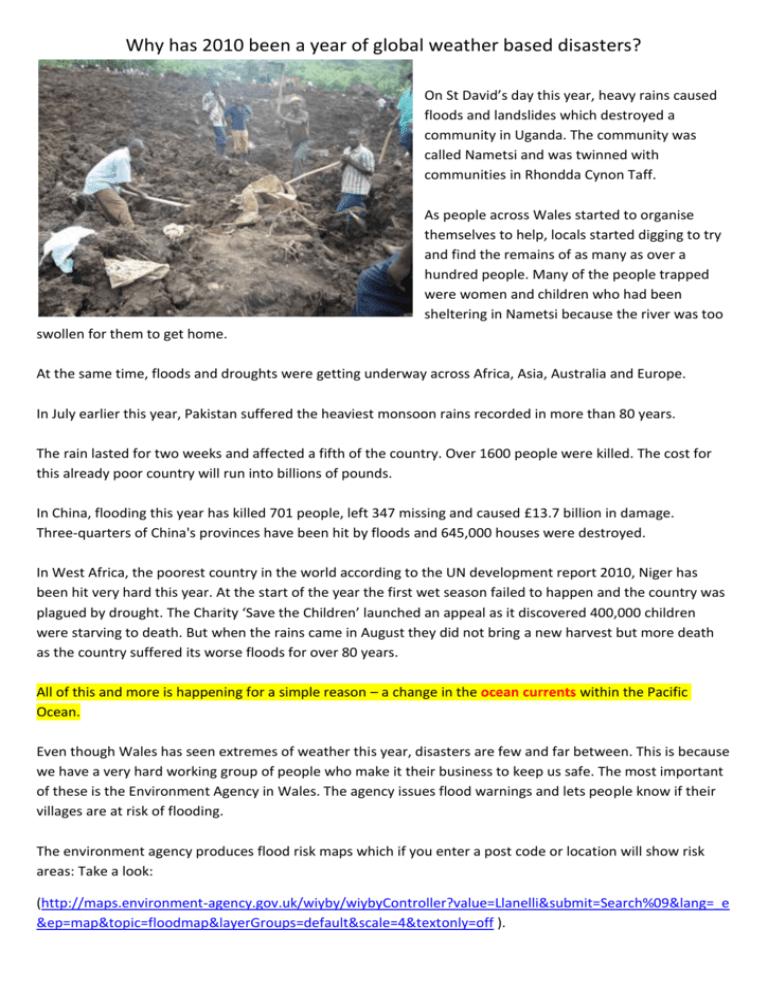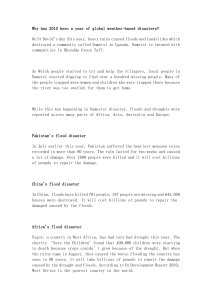KS3 Global Weather - Geography in the News
advertisement

Why has 2010 been a year of global weather based disasters? On St David’s day this year, heavy rains caused floods and landslides which destroyed a community in Uganda. The community was called Nametsi and was twinned with communities in Rhondda Cynon Taff. As people across Wales started to organise themselves to help, locals started digging to try and find the remains of as many as over a hundred people. Many of the people trapped were women and children who had been sheltering in Nametsi because the river was too swollen for them to get home. At the same time, floods and droughts were getting underway across Africa, Asia, Australia and Europe. In July earlier this year, Pakistan suffered the heaviest monsoon rains recorded in more than 80 years. The rain lasted for two weeks and affected a fifth of the country. Over 1600 people were killed. The cost for this already poor country will run into billions of pounds. In China, flooding this year has killed 701 people, left 347 missing and caused £13.7 billion in damage. Three-quarters of China's provinces have been hit by floods and 645,000 houses were destroyed. In West Africa, the poorest country in the world according to the UN development report 2010, Niger has been hit very hard this year. At the start of the year the first wet season failed to happen and the country was plagued by drought. The Charity ‘Save the Children’ launched an appeal as it discovered 400,000 children were starving to death. But when the rains came in August they did not bring a new harvest but more death as the country suffered its worse floods for over 80 years. All of this and more is happening for a simple reason – a change in the ocean currents within the Pacific Ocean. Even though Wales has seen extremes of weather this year, disasters are few and far between. This is because we have a very hard working group of people who make it their business to keep us safe. The most important of these is the Environment Agency in Wales. The agency issues flood warnings and lets people know if their villages are at risk of flooding. The environment agency produces flood risk maps which if you enter a post code or location will show risk areas: Take a look: (http://maps.environment-agency.gov.uk/wiyby/wiybyController?value=Llanelli&submit=Search%09&lang=_e &ep=map&topic=floodmap&layerGroups=default&scale=4&textonly=off ). If you register your address, they will send you a text, email or call you with a recorded message if there is a flood watch, flood warning or severe flood warning which might affect you. Probably the most visible activities of the Environment Agency in Wales are the flood schemes to prevent flooding across Wales. Check out their website to find out about current flood protection schemes in Fairbourne, Abergele, Dolgellau, Afon Rhyd-hir, Pwllheli, Bangor-on-Dee, Caersws, Chepstow, Conwy Valley, Hereford, Llandovery, Llanfyllin, Meifod, Rhydymwyn and Rossett. http://www.environment-agency.gov.uk/homeandleisure/floods/31728.aspx Activity Decision Making Exercise Find out about the risk of flooding in and around where you live or go to school. Use the environment agency website to help you. Look at different flood schemes in Wales and make a decision on what aspects of other schemes would work in your local area. Brain Box Flood Warnings What it means Flooding of low lying land and roads is expected. Be aware, be prepared, watch out. What to do Monitor local news and weather forecasts. Be aware of water levels near you. Be prepared to act on your flood plan. Check on the safety of pets and livestock. Charge your mobile phone. What it means Flooding of homes and businesses is expected. Act now! What to do Move cars, pets, food, valuables and important documents to safety. Get flood protection equipment in place. Turn off gas, electricity and water supplies if safe to do so. Be prepared to evacuate your home. Protect yourself, your family and help others. Act on your flood plan. Severe flooding is expected. What it means There is extreme danger to life and property. Act now! What to do Collect things you need for evacuation. Turn off gas, electricity and water supplies if safe to do so. Stay in a high place with a means of escape. Avoid electricity sources. Avoid walking or driving through flood water. In danger call 999 immediately. Listen to emergency services. Act on your flood plan Brain Box Ocean Currents in the Pacific Ocean Under normal conditions the winds in the Pacific Ocean drive warm surface water westwards where it ‘piles up’ around Australia and Indonesia. This allows cold water off the coast of South America to rise to the surface. This causes warm moist air in the west and colder drier air in the east. If the winds weaken above the Pacific Ocean, the warm water in the west flows towards the east. This causes heavy rains in South America and droughts in places like Australia. The local fishermen in Peru called these weather conditions El Niño. This happened in December – March in 2010 causing the climate disasters around the world at the start of the year. After El Niño the winds did not go back to normal but became much stronger than normal. So even more warm water than usual was piled up in the west of the Pacific and it was this that helped trigger the floods in July and August. These conditions are called La Niña by the local fishermen.







